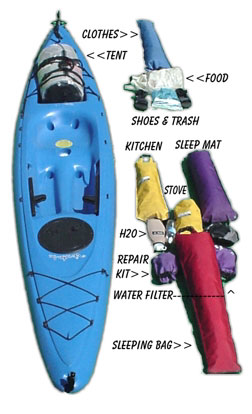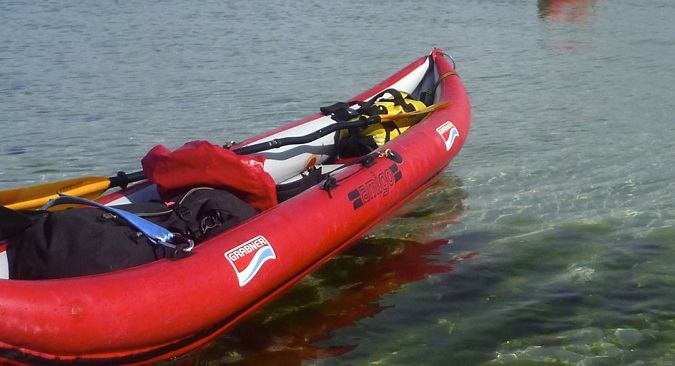When the summer camping and touring season is here those of you who are new to the ways of the vagabond kayaker will want to take careful note of the optimal way to load and pack your kayak. By properly storing your supplies and gear and placing them appropriately into your kayak, you can be ensured of good paddling performance, a dry bed, and lots of room for camping fun.

What To Take Along
Have a good grasp on what you are going to bring on your kayak camping expedition. Think carefully about this, you will be paddling into the wilderness far from stores, and you cannot bring everything.
Your basic camping gear, food, emergency stuff, etc. should suffice. To start you thinking, use the checklist at the left.
Because you do have a boat to carry a heavy load, it is tempting to get a bit extravagant and bring some heavy food items or some extra cargo, or something fun do, like a book or game for days when you are wind bound; Do so, but a good rule is to never bring more than you can keep under the deck.
Keeping Things Dry
Once you have identified all the stuff you are to take along, then you must get dry bags for everything that is not already waterproof.
All kayaks get a bit wet inside and the rougher the water the wetter they get. Our TopKayaker Shop and some outfitters carry dry bags and boxes in a variety of shapes and sizes designed to keep your stuff dry.
The bags will roll up at the top, snap or zip closed. The boxes will have a rubber seal and snap closed. You may even find some that have a lid that screws down like a jar. Don’t use trash bags, plastic bags (with the exception of freezer zip lock types) stuff sacks, or duffels; they will not keep things dry.
While picking out your dry bags THE SIZE OF YOUR KAYAK’S HATCH IS VERY IMPORTANT. You will need to take a few other things into consideration, as well.
Make sure that the bag, when full, will fit into the hatch. The space inside the kayak is not usually the problem. If you run into trouble and you find yourself at the put-in with a bag that is too big, you can put the empty bag into the kayak, and then load the items one at a time to fill the bag while inside the hull.
This will work but it is time-consuming. Also, make sure that the bags you have selected will fit the intended cargo. Test loading the bags and the cargo you’re carrying into your kayak before the trip is the only way you will be sure.
Where To Pack What
Quick access items: (A) – Put these things into the kayak last to make them the first things available. They will likely ride on top of other bags in your hull, this can help to keep them higher and dryer.
Some of your stuff may not need to be in bags or boxes at all: camp sandals, fuel bottles, water bottles and trash bags can go in the hull wily nily. It is ok for sandals to get a bit wet in the bilge, but seal your fuel and water bottles tight. Put your trash in two or more 1-gallon freezer zip lock bags.
Don’t use a big trashcan liner; they are too big and bulky.
Important To Note: Always pack your food in the same bag for every trip to avoid a carryover of odors that may attract unwanted guest in the wilderness. Never store your white gas fuel, camp stove, or lantern in the same bag as your food, or mess kit. If it leaks your meals will taste bad and make you sick. Use your oldest or cheapest dry bag to put these things in. Leaking white gas will ruin a dry bag. Hopefully, your stove will never leak but it is a possibility.
Try not to store a lot of stuff, if anything at all, on the deck of your kayak. First of all, it may fall off and sink. Also, it will make your top heavy and more likely to tip over. It can get in the way of your paddling and it allows the wind to push your kayak harder; however, sometimes you do not have a choice. Just make sure that it is tied down well, in a good place, and is not too heavy.
You might ask, “But that is the best thing about a sit-on-top kayak! I can keep things right in reach on the deck!” Well, that’s true only to a point.
Items to keep on deck (B) – Secure them well within easy reach. If you have short legs the extra foot wells are a good place to tie small items. Some PFDs have backpacks for water and emergency stuff. Use the pockets in your life vest for snacks and sunscreen as well as your whistle and signal mirror. Having a backrest with a pocket will provide a place to store a jacket or spare rope. Sometimes you can hold things in your lap if the water is not rough.
There are quite a few sit-on-tops with cargo decks or scuba tank wells. These can be handy for storing bulky packages like coolers tents or sleeping bags. It is important to use a quality dry bag in good shape for this spot because it will be very wet. You may need to add extra straps for these cargo decks if you plan to negotiate the surf zone. Test your tie-downs by grabbing your bag and yanking on it.
Packing Without Compromising The Integrity of Your Kayak’s Performance
Preserve the integrity of your kayak hull design and your paddling performance, by loading your kayak evenly. No matter how much you enjoy the model of kayak you’ve invested in, they all paddle differently when loaded with camping gear. It is important to load the kayak so that it is not lopsided, leaning to one side or the other, or too heavy in the front or back.
Packing Your Kayak
Put the lightest loads in the bow and stern. A sleeping bag, extra clothing, camp mattress, and other light items that you do not need instant access to our best put all the way into the ends of the hull, front and back. Skinny, pointy bags are best for these spots.
Put your heaviest loads in the middle of the kayak. Drinking water is the heaviest thing you will be carrying. You may be bringing along a lot if you do not have a source of drinking water at your campsite. Water bottles and bags will often fit under the cockpit of your kayak in a variety of odd-shaped nooks and crannies.
Put your bags on strings or bring a stick or hook to fish out hard-to-reach packages deep in the hull. Take a good look in there, and stick your head right in, if you can, to explore the possibilities.
Under the seating area is also a good place to put other small bags and boxes heavy or not. The idea is to get as much of the load in the center of the kayak as you can. Make sure that you load evenly side to side. Balance the cargo and make sure that it will not shift if you tip your kayak.
You may not be able to get under your cockpit. Some kayaks have bulkheads that prevent putting cargo there. Some of your heavy bags may be too big to fit in that space. Placing these bags close to the seating area is just as good. Tents, food bags, and cooking kits are all good candidates for this location.
You may be thinking that you need a scale to load your boat evenly. You don’t. Just try to get the load even bow to stern, and when in doubt, load a little bit heavier in the rear. Tents, food, and water are usually heavyweights. Your kayak will paddle better if the weight is toward the stern than toward the bow.
In conclusion, remember these points:
- Use Dry bags & boxes for everything.
- Test pack your cargo in the kayak before your trip.
- Store heavy packages in the middle of the kayak.
- Store light packages in the bow and stern.
- When in doubt, load heavier items in the back
- Load lighter ones in the front.
- Use the space under your cockpit if you can.
- Remember, the first things into the kayak are the last things out.
- Keep your deck clear of cargo, unless your kayak has a cargo well.
- And, last of all, make sure you pack fun into your kayak camping expedition.

